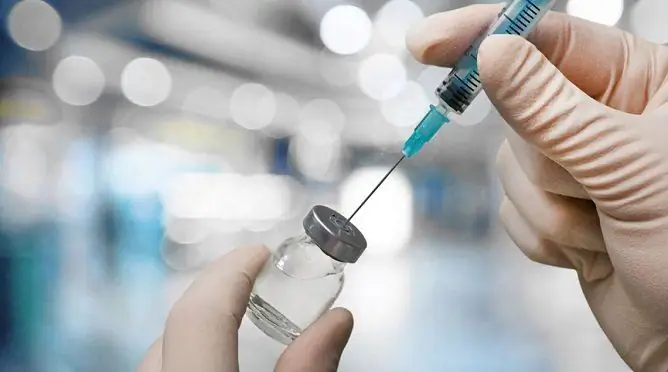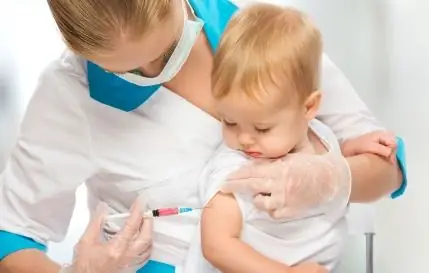- Author Rachel Wainwright [email protected].
- Public 2023-12-15 07:39.
- Last modified 2025-11-02 20:14.
Infanrix Hexa
Infanrix Hexa: instructions for use and reviews
- 1. Release form and composition
- 2. Pharmacological properties
- 3. Indications for use
- 4. Contraindications
- 5. Method of application and dosage
- 6. Side effects
- 7. Overdose
- 8. Special instructions
- 9. Drug interactions
- 10. Analogs
- 11. Terms and conditions of storage
- 12. Terms of dispensing from pharmacies
- 13. Reviews
- 14. Price in pharmacies
Latin name: Infanrix HEXA
ATX code: J07CA09
Active ingredient: vaccine for the prevention of diphtheria, pertussis, poliomyelitis, tetanus and infections caused by Haemophilus influenzae type b
Producer: GlaxoSmithKline Biologicals (Belgium), Smithkline Beecham-Biomed (Russia)
Description and photo update: 2018-26-10
Prices in pharmacies: from 1888 rubles.
Buy

Infanrix Hexa is a combination vaccine for the prevention of hepatitis B, tetanus, poliomyelitis, pertussis, diphtheria, and an infection caused by Haemophilus influenzae type b.
Release form and composition
The dosage form of the release of Infanrix Hex is a suspension for intramuscular (i / m) administration:
- adsorbed vaccine, combined for the prevention of hepatitis B, poliomyelitis (inactivated), pertussis (acellular), tetanus, diphtheria: white, separating on settling into a white precipitate (completely broken when shaken) and a colorless transparent liquid (in 0.5 ml syringes);
- vaccine adsorbed, conjugated for the prevention of infection caused by Haemophilus influenzae type b: white lyophilized powder or dense mass; solution recovered from the lyophilisate: opaque, separating upon settling into a colorless liquid and a white precipitate, easily resuspended by shaking (in neutral glass vials, 1 dose).
1 syringe with suspension with 2 needles (or without them) is placed in separate plastic containers complete with 1 bottle of lyophilisate in a blister; in a cardboard box 1 set.
Active substances in 0.5 ml of an adsorbed, combined vaccine for the prevention of hepatitis B, diphtheria, poliomyelitis (inactivated), pertussis (acellular), tetanus:
- diphtheria toxoid - at least 30 international units (ME);
- tetanus toxoid - not less than 40 ME;
- pertussis toxoid - 0.025 mg;
- filamentous hemagglutinin - 0.025 mg;
- pertactin (69 kDa outer membrane protein) - 0.008 mg;
- surface antigen recombinant hepatitis B virus (HBsAg) - 0.01 mg;
- poliomyelitis virus type 1 inactivated - 40 units (U) of D-antigen;
- poliomyelitis virus type 2 inactivated - 8 IU of D-antigen;
- poliomyelitis virus type 3 inactivated - 32 units of D-antigen.
Auxiliary components: water for injection - up to 0.5 ml; aluminum phosphate - 0.2 mg; aluminum hydroxide - 0.5 mg; Wednesday 199 (M 199) - 1.15 mg (including amino acids - 0.09 mg); sodium chloride - 4.5 mg.
Composition of 0.5 ml of an adsorbed, conjugated vaccine for the prevention of infection caused by Haemophilus influenzae type b:
- active substance: capsular polysaccharide of Haemophilus influenzae type b - 0.01 mg (conjugated with tetanus toxoid ~ 0.025 mg);
- auxiliary components: aluminum phosphate - 0.12 mg; lactose - 12.6 mg.
Pharmacological properties
Pharmacodynamics
The immunogenicity of Infanrix Hex was evaluated in clinical trials in children aged 42 days of age using two-dose and three-dose primary vaccination regimens followed by revaccination.
The protective level of antibodies to each of the vaccine antigens using the three-dose regimen was determined in 95.7% (at least) of the vaccinated. The protective level of antibodies to each of the vaccine antigens after revaccination was determined in 98.4% (at least) of vaccinated children.
Protective titers (antibodies) depending on the age of children after 1 month after completion of the three-dose primary course of vaccination were:
- diphtheria toxoid (0.1 IU per 1 ml): age 2-3-4 months, number of vaccinated (N) = 196 (2 studies) - 100%; 2-4-6 months N = 1693 (6 studies) - 99.8%; 3-4-5 months N = 1055 (6 studies) - 99.7%;
- tetanus toxoid (0.1 IU per 1 ml): age 2-3-4 months N = 196 (2 studies) - 100%; 2-4-6 months N = 1693 (6 studies) - 100%; 3-4-5 months N = 1055 (6 studies) - 100%;
- pertussis toxoid (5 ELISA E per 1 ml): age 2-3-4 months N = 196 (2 studies) - 100%; 2-4-6 months N = 1693 (6 studies) - 100%; 3-4-5 months N = 1055 (6 studies) - 99.8%;
- filamentous hemagglutinin (5 ELISA E per 1 ml): age 2-3-4 months N = 196 (2 studies) - 100%; 2-4-6 months N = 1693 (6 studies) - 100%; 3-4-5 months N = 1055 (6 studies) - 100%;
- pertactin (5 ELISA U / ml): age 2-3-4 months N = 196 (2 studies) - 100%; 2-4-6 months N = 1693 (6 studies) - 100%; 3-4-5 months N = 1055 (6 studies) - 99.7%;
- surface antigen of hepatitis B virus HBsAg (10 mIU / ml): age 2-3-4 months N = 196 (2 studies) - 99.5%; 2-4-6 months N = 1693 (6 studies) - 98.9%; 3-4-5 months N = 1055 (6 studies) - 98%;
- polio virus type 1 (dilution 1: 8): age 2-3-4 months N = 196 (2 studies) - 100%; 2-4-6 months N = 1693 (6 studies) - 99.9%; 3-4-5 months N = 1055 (6 studies) - 99.7%;
- poliomyelitis virus type 2 (dilution 1: 8): age 2-3-4 months N = 196 (2 studies) - 97.8%; 2-4-6 months N = 1693 (6 studies) - 99.3%; 3-4-5 months N = 1055 (6 studies) - 98.9%;
- poliomyelitis virus type 3 (dilution 1: 8): age 2-3-4 months N = 196 (2 studies) - 100%; 2-4-6 months N = 1693 (6 studies) - 99.7%; 3-4-5 months N = 1055 (6 studies) - 99.7%;
- capsular polysaccharide of Haemophilus influenzae type b (0.15 μg per 1 ml): age 2-3-4 months N = 196 (2 studies) - 96.4%; 2-4-6 months N = 1693 (6 studies) - 96.6%; 3-4-5 months N = 1055 (6 studies) - 96.8%.
Protective titers (antibodies) when using 4 doses of Infanrix Hex in cases of revaccination in the second year of life after a three-dose primary vaccination (N = 2009; 12 studies) were:
- diphtheria toxoid (0.1 IU per 1 ml): 99%;
- tetanus toxoid (0.1 IU per ml): 99%;
- pertussis toxoid (5 ELISA E per 1 ml): 99%;
- filamentous hemagglutinin (5 ELISA E per 1 ml): 99%;
- pertactin (5 ELISA U / ml): 99.5%;
- surface antigen of hepatitis B virus HBsAg (10 mIU / ml): 98.4%;
- poliomyelitis virus type 1 (dilution 1: 8): 99%;
- poliomyelitis virus type 2 (dilution 1: 8): 99%;
- poliomyelitis virus type 3 (dilution 1: 8): 99%;
- Capsular polysaccharide of Haemophilus influenzae type b (0.15 μg per ml): 99.7%.
Protective titers (antibodies) after 1 month after the end of the two-dose primary course of vaccination followed by revaccination, depending on the child's age, were:
- diphtheria toxoid (0.1 IU per 1 ml): 2-4-12 months, N = 196 (1 study) - 100%; 3-5-11 months, N = 352 (3 studies) - 100%;
- tetanus toxoid (0.1 IU per 1 ml): 2-4-12 months, N = 196 (1 study) - 100%; 3-5-11 months, N = 352 (3 studies) - 100%;
- pertussis toxoid (5 ELISA E per 1 ml): 2-4-12 months, N = 196 (1 study) - 99.5%; 3-5-11 months, N = 352 (3 studies) - 100%;
- filamentous hemagglutinin (5 ELISA E per 1 ml): 2-4-12 months, N = 196 (1 study) - 100%; 3-5-11 months, N = 352 (3 studies) - 100%;
- pertactin (5 ELISA U / ml): 2-4-12 months, N = 196 (1 study) - 100%; 3-5-11 months, N = 352 (3 studies) - 99.2%;
- surface antigen of hepatitis B virus HBsAg (10 mIU / ml): 2-4-12 months, N = 196 (1 study) - 99.8%; 3-5-11 months, N = 352 (3 studies) - 98.9;
- poliomyelitis virus type 1 (dilution 1: 8): 2-4-12 months, N = 196 (1 study) - 98.4%; 3-5-11 months, N = 352 (3 studies) - 99.8%;
- poliomyelitis virus type 2 (dilution 1: 8): 2-4-12 months, N = 196 (1 study) -98.4%; 3-5-11 months, N = 352 (3 studies) - 99.4%;
- poliomyelitis virus type 3 (dilution 1: 8): 2-4-12 months, N = 196 (1 study) - 97.9%; 3-5-11 months, N = 352 (3 studies) - 99.2%;
- capsular polysaccharide of Haemophilus influenzae type b (0.15 mcg per 1 ml): 2-4-12 months, N = 196 (1 study) - 100%; 3-5-11 months, N = 352 (3 studies) - 99.6%.
The protective effectiveness of Infanrix Hex against whooping cough varies from 84 to 88.7%. This is confirmed by the results of clinical studies carried out in Italy in children aged 2-4-6 months and in Germany in children 3-4-5 months. After the completion of the primary pertussis vaccination scheme in Italy, without revaccination, for 60 months the protective efficacy was retained in the same group of children.
The immunogenicity of Infanrix Hex was evaluated by clinical studies after the completion of a three-dose primary vaccination course in children aged 2-4-6 months in approximately 300 premature infants born from 24 to 36 weeks of pregnancy, and after revaccination in children aged 18 to 24 months - in about 200 premature babies.
After 1 month after the end of the primary vaccination course, 98.7% of the vaccinated (at least) achieved the level of seroprotection against poliomyelitis virus types 1 and 2, tetanus and diphtheria; 90.9% of the vaccinated (at least) achieved a protective level of antibodies to poliomyelitis virus type 3, viral hepatitis B antigen and capsular polysaccharide of Haemophilus influenzae type b. In relation to antibodies to pertussis toxoid, 94.9% of the vaccinated were seropositive; to filamentous hemagglutinin and pertactin - all vaccinated.
After 1 month after revaccination, 98.4% of the vaccinated (at least) had a protective level of antibodies to each of the vaccine antigens, with the exception of pertussis toxoid (at least 96.8%) and hepatitis B virus antigen (at least 88, 7%). In terms of increasing the concentration of antibodies (15-235 times), the response to the introduction of a booster dose indicates the adequacy of primary vaccination in relation to all antigens contained in Infanrix Hexa.
Studies conducted 2.5-3 years after revaccination confirmed the persistence of seroprotection against the hepatitis B virus in 85.3% of the vaccinated; against capsular polysaccharide of Haemophilus influenzae type b and poliomyelitis virus types 1, 2, 3 - in 95.7% (not less).
After completion of the three-dose course of primary vaccination with further revaccination with the drug, the duration of the immune response was assessed in children 4-8 years old. In 91% of children (at least), immune protection was observed against polio virus types 1, 2, 3 and capsular polysaccharide of Haemophilus influenzae type b; in 64.7% of children (at least) - against tetanus and diphtheria.
Seropositive to the pertussis components of the vaccine remained at least 87% (antibodies to PRN); 97.5% (antibodies to PHA); 25.4% (antibodies to pertussis toxoid) of children.
In relation to viral hepatitis B, immune protection after the end of a three-dose course of primary vaccination with further revaccination with the drug was observed in more than 85% of vaccinated children aged 4-5 years and in more than 72% of vaccinated children aged 7-8 years.
In 48% (at least) of vaccinated children aged 11-12 years, after completing a two-dose course of primary vaccination followed by revaccination, immune protection against viral hepatitis B was observed.
The preservation of immune memory against the hepatitis B virus was also confirmed in children 4-12 years of age. These children underwent a course of primary vaccination followed by revaccination with the drug. In 96.8% (at least) of the vaccinated, the induction of immune protection was noted after the introduction of an additional dose of monovalent vaccine for the prevention of viral hepatitis B.
Indications for use
According to the instructions, Infanrix Hexa is prescribed for primary vaccination and revaccination of children against the following diseases / infections:
- polio;
- diphtheria;
- Hepatitis B;
- tetanus;
- whooping cough;
- Haemophilus influenzae type b infection.
Contraindications
Absolute:
- encephalopathy of unknown origin, which developed within 7 days after the previous administration of the vaccine with the pertussis component. In such cases, the pertussis vaccination is canceled and the administration of only the diphtheria-tetanus vaccine, as well as the vaccine against hepatitis B, polio and infection caused by Haemophilus influenzae type b, is continued;
- acute infectious / non-infectious pathologies, exacerbation of chronic diseases (temporary contraindications to vaccinations); scheduled vaccinations are carried out after 14-28 days after recovery or during remission or convalescence; in cases of mild acute respiratory viral infections and acute intestinal diseases, vaccinations are carried out immediately after the temperature has returned to normal;
- hypersensitivity after a previous vaccine against Haemophilus influenzae type b, polio, hepatitis B, pertussis, tetanus, or diphtheria;
- individual intolerance to the components contained in the preparation, as well as neomycin and polymyxin.
Relative (diseases / conditions in the presence of which the appointment of Infanrix Hex requires caution):
- thrombocytopenia;
- disorders of the blood coagulation system.
Instructions for the use of Infanrix Hex: method and dosage
The suspension (1 dose of 0.5 ml) is injected deeply into the / m, into the middle third of the anterolateral surface of the thigh, alternating sides during subsequent injections. Infanrix Hexa cannot be administered intradermally or intravenously.
The course of primary vaccination in accordance with the National Calendar of Preventive Vaccinations of the Russian Federation consists of three doses of vaccine, which are administered in 3; 4.5 and 6 months. However, on the recommendation of a doctor, it is possible to use a different three-dose and two-dose primary vaccination scheme. It is important to observe the interval between injections of Infanrix Hex 1 month (at least).
Revaccination, in accordance with the National Calendar of Preventive Vaccinations of the Russian Federation, is carried out once every 18 months of life. On the recommendation of a doctor, revaccination can be carried out at a different time, observing an interval of 6 months (at least) from the last vaccination of the primary course. The booster dose after a two-dose course of primary vaccination is recommended between 11 and 13 months of age; after a three-dose course of primary vaccination - up to 18 months.
In case of any violation of the vaccination schedule, one should be guided by the instructions for the use of Infanrix Hex and the recommendations of the National Calendar of Preventive Vaccinations of the Russian Federation.
Infanrix Hexa vaccine is not used in children over the age of 36 months.
For premature babies (at least 24 weeks of gestation), the recommended vaccination schedule consists of 3 vaccinations with further revaccination. It is important to observe the interval between injections of 1 month (at least). The revaccinating dose is administered after 6 months (not earlier) from the last vaccination of the primary course, preferably up to 18 months of life.
Before use, the syringe with the adsorbed, combined vaccine for the prevention of hepatitis B, poliomyelitis (inactivated), pertussis (acellular), tetanus and diphtheria is shaken until a homogeneous homogeneous whitish suspension is obtained.
It is important to visually inspect both types of Infanrix Hexa vaccine for mechanical impurities and / or changes in appearance. If they are found, the vaccine cannot be used.
When using a package with two needles, before reconstitution of the vaccine, the protective rubber cap is removed from the syringe nozzle and a sterile needle from a separate plastic container is tightly attached to the syringe.
To reconstitute the vaccine, remove the protective plastic cap and aluminum cap from the vial containing the lyophilisate. Next, in a vial with a vaccine for the prevention of infection caused by Haemophilus influenzae type b, conjugated, adsorbed (lyophilisate) with a needle (piercing the rubber stopper of the vial), the adsorbed vaccine contained in the syringe, combined for the prevention of hepatitis B, poliomyelitis (inactivated), pertussis (acellular), tetanus, diphtheria (suspension). It is important to wait until the lyophilisate is completely dissolved without disconnecting the syringe from the vial (but not more than 5 minutes).
The reconstituted vaccine appears to be a more turbid suspension than the original reconstitution vaccine. If there are other changes, the vaccine is destroyed.
After that, the suspension is taken back into the syringe, the needle is changed to a new one and immediately introduced. The reconstituted vaccine can be kept at a temperature of 21 ° C for 8 hours.
It is recommended to administer the vaccine warmed to room temperature. Heating to room temperature also provides the necessary elasticity to the rubber bottle stopper. To do this, for 5 minutes, the bottle is left at a temperature of 25 ± 3 ° C before the suspension is introduced from the syringe.
The available data indicate the possibility of storing the components of the kit at a temperature not exceeding 25 ° C for 6 days. During this period, Infanrix Hexa must be used, and after this period, the unused product is destroyed.
Side effects
Possible adverse reactions (> 10% - very common;> 1% and 0.1% and 0.01% and <0.1% - rarely; <0.01% - extremely rare):
- infectious and parasitic pathologies: infrequently - infection of the upper respiratory tract;
- metabolism and nutrition: very often - loss of appetite;
- psyche: very often - anxiety, unusual crying, irritability; often - excitability;
- nervous system: infrequently - drowsiness; extremely rare - convulsions (with or without fever);
- respiratory system, chest and mediastinal organs: infrequently - cough; rarely - bronchitis;
- gastrointestinal tract: often - diarrhea, vomiting;
- skin and subcutaneous tissue: often - itching; rarely - rash; extremely rare - urticaria, dermatitis;
- general disorders and disorders at the injection site: very often - fatigue, an increase in body temperature over 38 ° C, edema at the injection site (d 5 cm); infrequently - diffuse edema of the limb into which Infanrix Hexa was injected, sometimes with the involvement of the adjacent joint.
Post-registration observations:
- blood and lymphatic system: rarely - thrombocytopenia, lymphadenopathy;
- immune system: rarely - allergic reactions (including anaphylactoid / anaphylactic reactions);
- nervous system: rarely - hypotensive-hyporesponsive syndrome (shock-like state or collapse);
- respiratory system, organs of the chest and mediastinum: rarely - apnea;
- skin and subcutaneous tissues: rarely - angioedema;
- violations at the injection site and general disorders: rarely - vesicles at the injection site, edema / severe edema of the entire limb into which the injection was made.
Overdose
There are no data on an overdose of Infanrix Hex.
special instructions
Before the administration of the drug, an examination is carried out and the history of the child is studied, paying attention to previous vaccinations and the likelihood of side effects.
As with any vaccination, not all people who are vaccinated may have a protective immune response.
Infanrix Hexa does not prevent the development of pathologies caused by any other pathogens, except for diphtheria corynebacterium, tetanus or pertussis bacillus, hepatitis B virus, polio virus types 1, 2, 3 and Haemophilus influenzae type b. However, a preventive effect against hepatitis D is expected, which can be prevented by vaccination, since hepatitis D (caused by hepatitis delta virus) does not occur in the absence of hepatitis B.
Since with the introduction of Infanrix Hex, like any other vaccines, an anaphylactic reaction may develop, it is important to have everything you need ready to stop it. For 30 minutes after immunization, the vaccinated must be under medical supervision.
In cases of the following reactions, in time associated with the administration of a vaccine containing a pertussis component, the decision to use Infanrix Hex is possible only after correlating the possible risks with the benefits (high incidence of whooping cough):
- an increase in body temperature of more than 40 ° C, which has developed over 2 days, which has no other identifiable cause;
- hypotensive-hyporesponsive syndrome that developed within 2 days after vaccination;
- incessant crying, lasting for 3 hours or more, arising within 2 days after vaccination;
- convulsions with or without elevated body temperature that occurred within 3 days after the administration of the vaccine.
For progressive neurological disorders, including infantile spasms, uncontrolled epilepsy, or progressive encephalopathy, pertussis vaccination is postponed until the condition is corrected or stabilized. The decision to prescribe a vaccine with a pertussis component is made on an individual basis after careful consideration of the potential benefits and potential risks.
An increase in body temperature is more common in children receiving the drug simultaneously with the pneumococcal conjugate vaccine, compared with children receiving only Infanrix Hexa vaccine.
With the combined use of the drug with the Prevenar 13 vaccine, an increase in the incidence of hypotensive-hyporesponsive syndrome and seizures (with or without an increase in body temperature) was observed in comparison with the use of Infanrix Hexa vaccine alone.
As a psychological reaction to vaccination after, and sometimes before it, there is severe weakness and fainting. In this regard, it is important to make sure that the child is not injured by possible fainting before administering the drug.
With a history of seizures with a high body temperature, as well as a family history of seizures and sudden death syndrome, careful monitoring of the vaccine is required for 2-3 days after the administration of Infanrix Hex (during this period, side effects may occur).
An immune response may not be achieved in HIV-infected patients.
Infanrix Hexa is allowed to be used in premature babies. In such cases, the immune response to some antigens is lower, which is typical for this category of vaccinated. It is important to take into account the possible risk of developing apnea and the need to monitor respiratory function for 6 days with the primary vaccination of children born before 28 weeks of gestation and, especially, with a history of respiratory distress syndrome.
Since vaccination of children in this group is necessary, it is not recommended to postpone or refuse the primary vaccination. In such cases, it is carried out in a hospital under medical supervision (for 6 days).
When conducting a urinalysis after 7-14 days after the administration of the drug, a positive test may be recorded, since the antigen of the capsular polysaccharide of Haemophilus influenzae type b is excreted in the urine. Other tests are done during this period to confirm the diagnosis of Haemophilus influenzae type b infection.
Drug interactions
Infanrix Hexa can be administered in combination with a vaccine for the prevention of chickenpox, rubella, mumps, measles, rotavirus infection, meningococcal vaccine (serogroup A, C, W, Y) conjugated, meningococcal (serogroup C) conjugated, pneumococcal conjugated.
The drug should not be mixed with other vaccines in the same syringe.
Analogs
The analogs of Infanrix Hex are: Infanrix, Pentaxim, Tetraksim.
Terms and conditions of storage
Store in a place protected from light and moisture at temperatures up to 8 ° C. Keep out of the reach of children. Do not freeze.
The shelf life is 3 years.
Terms of dispensing from pharmacies
Released for hospitals.
Reviews of Infanrix Hexa
According to reviews, Infanrix Hexa is an effective vaccine that is well tolerated by children. In rare cases, rapidly passing tearfulness, an increase in body temperature and local reactions are noted. Parents emphasize that it is much easier for a child to tolerate than local vaccines, is multicomponent, well-purified and safe.
Almost all reviews of the vaccine are extremely positive, as disadvantages they only note that it is paid, it is quite expensive and is not always on sale.
Price for Infanrix Hexa in pharmacies
The approximate price of Infanrix Hexa vaccine for 1 dose in a package is 700 rubles.
Infanrix Hexa: prices in online pharmacies
|
Drug name Price Pharmacy |
|
Infanrix Hexa Vaccine 0.5 ml / dose suspension for intramuscular administration of 0.5 ml 1 pc. 1888 RUB Buy |

Anna Kozlova Medical journalist About the author
Education: Rostov State Medical University, specialty "General Medicine".
Information about the drug is generalized, provided for informational purposes only and does not replace the official instructions. Self-medication is hazardous to health!






